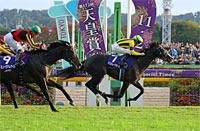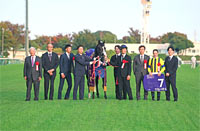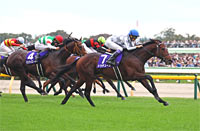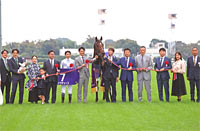Tenno Sho (Autumn) (G1) - Data Analysis
Ultimate middle-distance race that has produced a large number of memorable contests
Last year’s Tenno Sho (Autumn) unfolded as a fierce battle between Triple Crown winner Contrail, short-distance champion Gran Alegria, and three-year-old Satsuki Sho (Japanese 2000 Guineas) winner Efforia. This 2,000m turf race is held at Tokyo Racecourse, and brings together elite runners from different paths. Let’s now look for some historical trends based on results over the last 10 years.
Runners coming from JRA G1 races have fared well in recent years
The Top 3 finishers over the last 10 years were all runners that had contested a JRA G1 or G2 race last time out, with both groups comprising 15 runners. However, the group coming from G1 races sharply outperformed the one coming from G2 races in terms of success ratios, and virtually dominated the Top 3 in the last three years with three winners, three runners-up, and two thirds. This year, we should again focus on runners coming from a JRA G1 race. [Table 1]
[Table 1] Performance by previous race (last 10 years)
| Previous race |
Performance
[1st-2nd-3rd-4th or lower] |
Win ratio |
Top 2 ratio |
Top 3 ratio |
| JRA G1 |
4-7-4-24 |
10.3% |
28.2% |
38.5% |
| JRA G2 |
6-3-6-90 |
5.7% |
8.6% |
14.3% |
| Other race |
0-0-0-16 |
0% |
0% |
0% |
Strong performance by fillies/mares
Mares have exhibited noteworthy performance in the last three years. In 2019, Almond Eye and Aerolithe were the only two mares that entered the race, and they finished 1st and 3rd, respectively. In 2020, Almond Eye secured a consecutive victory in the race, while third place went to Chrono Genesis. Going back further in time, we find that Gentildonna consecutively finished 2nd in the 2013 and 2014 races . Over the last 10 years, fillies/mares have outperformed colts/horses and geldings with a Top 3 ratio of 50.0%. [Table 2]
[Table 2] Performance by gender (last 10 years)
| Gender |
Performance
[1st-2nd-3rd-4th or lower] |
Win ratio |
Top 2 ratio |
Top 3 ratio |
| Colts/horses and geldings |
8-8-7-123 |
5.5% |
11.0% |
15.8% |
| Fillies/mares |
2-2-3-7 |
14.3% |
28.6% |
50.0% |
Battle between runners aged 3 to 5
Looking at performances by runners over the last 10 years in terms of age, we find that four-year-olds and five-year-olds each produced 13 Top 3 finishers. Three-year-olds achieved a decent Top 3 ratio despite entering the race in smaller numbers, but Efforia’s victory last year marked the first win for a three-year-old in 19 years. Meanwhile, the only runner aged 6 or above to finish in the Top 3 was Eishin Flash in 2013 (third place), which suggests we should sharply lower our expectations of runners in this group. [Table 3]
[Table 3] Performance by age (last 10 years)
| Age |
Performance
[1st-2nd-3rd-4th or lower] |
Win ratio |
Top 2 ratio |
Top 3 ratio |
| 3 |
1-1-1-9 |
8.3% |
16.7% |
25.0% |
| 4 |
3-6-4-27 |
7.5% |
22.5% |
32.5% |
| 5 |
6-3-4-39 |
11.5% |
17.3% |
25.0% |
| 6 |
0-0-1-29 |
0% |
0% |
3.3% |
| 7 or above |
0-0-0-26 |
0% |
0% |
0% |
Strong performance by runners with previous success in graded turf races held at Tokyo Racecourse
Of the 30 Top 3 finishers over the last 10 years, 27 had experience of finishing within the Top 3 of a graded turf race held at Tokyo Racecourse. Runners without such experience struggled with a Top 3 ratio of 5.6%. We should therefore expect little from runners that have not experienced success in a graded turf race held at Tokyo Racecourse. [Table 4]
[Table 4] Performance by experience of finishing in the Top 3 of a graded turf race held at Tokyo Racecourse (last 10 years)
| Experience |
Performance
[1st-2nd-3rd-4th or lower] |
Win ratio |
Top 2 ratio |
Top 3 ratio |
| Yes |
10-8-9-79 |
9.4% |
17.0% |
25.5% |
| No |
0-2-1-51 |
0% |
3.7% |
5.6% |
Conspicuous trend in sires
Looking at performances by runners over the last 10 years in terms of sire, we note that King Kamehameha sired two winners of the Tenno Sho (Autumn): Lovely Day (2015) and Rey de Oro (2018). In 2019 and 2020, the race was won by Almond Eye, a filly by Lord Kanaloa, who was sired by King Kamehameha. Runners that trace their lineage back to King Kamehameha have produced many winners, but few runners-up and third-place finishers. Meanwhile, Deep Impact sired the highest number of Top 3 finishers with only one winner (Spielberg in 2014) but eight runners-up and two third-place finishers. The progeny of Deep Impact entered the race in nine of the 10 years under analysis, and produced Top 2 finishers in eight of those years. [Table 5]
[Table 5] Performance by sire (last 10 years)
| Sire |
Performance
[1st-2nd-3rd-4th or lower] |
Win ratio |
Top 2 ratio |
Top 3 ratio |
| King Kamehameha |
2-0-1-16 |
10.5% |
10.5% |
15.8% |
| Lord Kanaloa |
2-0-0-2 |
50.0% |
50.0% |
50.0% |
| Deep Impact |
1-8-2-41 |
1.9% |
17.3% |
21.2% |
| King's Best |
1-0-1-0 |
50.0% |
50.0% |
100% |
| Heart's Cry |
1-0-0-8 |
11.1% |
11.1% |
11.1% |
| Epiphaneia |
1-0-0-0 |
100% |
100% |
100% |
| Screen Hero |
1-0-0-0 |
100% |
100% |
100% |
| Black Tide |
1-0-0-0 |
100% |
100% |
100% |
Note: Only horses that have sired a winner of the Tenno Sho (Autumn) are included in the list above.
Seek out the winner!
Highly favored former G1 winners have consistently notched the win in recent years
Highly favored runners have had an edge in recent years. The last seven winners were all backed as 3rd favorite or higher with win odds of less than 4.0. Other shared features among these seven winners were that they were all former G1 winners, and that they had won a domestic or overseas G1 race or G2 in the same year. [Table 6]
[Table 6] Winners’ performance by favoritism, win odds, G1 wins, and wins in graded races in same year (last seven years)
| Year |
Winner |
Favoritism |
Win odds |
G1 wins |
Wins in graded races in same year |
| 2015 |
Lovely Day |
1st favorite |
3.4 |
1 |
Takarazuka Kinen (G1), and four other wins |
| 2016 |
Maurice |
1st favorite |
3.6 |
4 |
Champions Mile (G1, Hong Kong) |
| 2017 |
Kitasan Black |
1st favorite |
3.1 |
5 |
Osaka Hai (G1), Tenno Sho (Spring) (G1) |
| 2018 |
Rey de Oro |
2nd favorite |
3.1 |
1 |
Sankei Sho All Comers (G2) |
| 2019 |
Almond Eye |
1st favorite |
1.6 |
5 |
Dubai Turf (G1, UAE) |
| 2020 |
Almond Eye |
1st favorite |
1.4 |
7 |
Victoria Mile (G1) |
| 2021 |
Efforia |
3rd favorite |
3.4 |
1 |
Satsuki Sho (Japanese 2000 Guineas) (G1), and one other win |
(Maya Takanami)
|


















